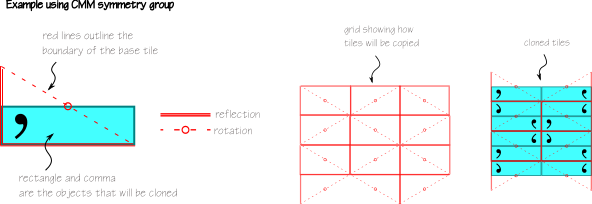Difference between revisions of "OnCanvasSymmetryTool"
m |
|||
| Line 16: | Line 16: | ||
UC 1) User has created one or more objects which they want to replicate using a group of symmetry relationships (rotation, reflection, translation or glide). The user must choose a symmetry group or create their own set of transformation rules. | UC 1) User has created one or more objects which they want to replicate using a group of symmetry relationships (rotation, reflection, translation or glide). The user must choose a symmetry group or create their own set of transformation rules. | ||
[[Media:WallpaperTransformations.png | Transformation base tiles for wallpaper groups]] | |||
In order to choose the symmetry relationships that will produce the desired effect, the user must understand how clones of the base tile will be transformed. For example, if the user selects a symmetry type of PM, they will want to know at a general level that the tile will be reflected in one direction and translated in an orthogonal direction. At a more specific level, they will want to know which direction and how far the pattern will be translated and across what line the pattern will be reflected. | |||
An on-canvas visualization of the base tile and of the tiling pattern is proposed. | An on-canvas visualization of the base tile and of the tiling pattern is proposed. | ||
* Draw | * Draw the outline of the base tile using different line styles and markings to indicate the transformation operations. | ||
* Draw a grid showing how the base tile will be translated across the plane. Cloned tiles will appear in the cells of the grid. | |||
[[File:cmmExample.png]] | |||
[[ | |||
== Implementation Considerations == | == Implementation Considerations == | ||
Revision as of 20:41, 6 June 2012
The On-Canvas Support for Creating and Modifying Wallpaper Symmetry Groups is based on the functionality currently available in the "Create Tiled Clones ..." dialog.
Description
Redesign parts of the Cloned Tiles User Interface. In particular, this project will focus on on-canvas control of the size, position, orientation and skew of the boundary of the base tile as well as on-canvas control of the number and “placement” of cloned tiles (placement refers to the attributes currently specified either by the row/column or the width/height fields in the current Create Cloned Tiles dialog).
Related Blueprints
- Tiling Tool for Wallpaper, Radial and Line tiling
Use Cases
UC 1) User has created one or more objects which they want to replicate using a group of symmetry relationships (rotation, reflection, translation or glide). The user must choose a symmetry group or create their own set of transformation rules.
Transformation base tiles for wallpaper groups
In order to choose the symmetry relationships that will produce the desired effect, the user must understand how clones of the base tile will be transformed. For example, if the user selects a symmetry type of PM, they will want to know at a general level that the tile will be reflected in one direction and translated in an orthogonal direction. At a more specific level, they will want to know which direction and how far the pattern will be translated and across what line the pattern will be reflected.
An on-canvas visualization of the base tile and of the tiling pattern is proposed.
- Draw the outline of the base tile using different line styles and markings to indicate the transformation operations.
- Draw a grid showing how the base tile will be translated across the plane. Cloned tiles will appear in the cells of the grid.
Implementation Considerations
For each proposed feature, three things must be considered:
- The user interaction
- How the SVG markup is affected
- The mathematics of the operation
- Guides for symmetry groups
- User interaction
- User enables guide display through menu or keyboard accelerator
- SVG markup
- Requires the base tile markup to have the following information:
- inkscape:tile-x0, inkscape:tile-y0, inkscape:tile-w, inkscape:tile-h (These items are already part of inkscapes Cloned Tile dialog.)
- inkscape:tile-type (This attribute is new for this feature. It stores the wallpaper symmetry group type. P1, P2, CMM etc)
- Requires the cloned tile markup to have the following information:
- transform - this attribute contains the transformation required to map the base tile outline to the cloned tile outline. This is the same transformation that is applied to the base tile object to obtain the size, position etc of the cloned object. Note that the base object may have been translated away from its original position. This translation
- Requires the base tile markup to have the following information:
- Math
- For each symmetry group type, determine the shape, size and position of the base tile.
- TODO This is currently done in symmetry-tool.cpp but should be documented here.
- User interaction
